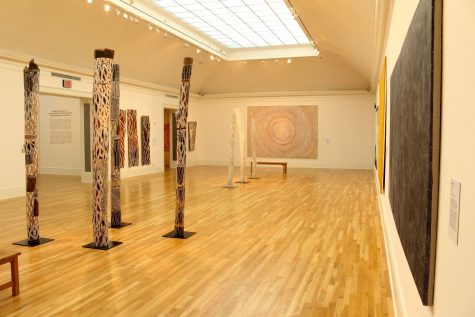Newcomb Art Museum paints new perspective on cultural issues

The Marking the Infinite: Contemporary Women Artists from Aboriginal Australia exhibition is part of the four recent exhibits to feature people of color.
Art speaks across all different cultures and societies — contemporary art across the prominent issues of the time. Recently, issues revolving around race and politics have been given space in the Newcomb Art Museum on Tulane’s campus.
In its last three exhibitions the museum has presented works of Aboriginal Australian art, photo-documentaries of Syrian refugees paired with the culturally inspired work of a Syrian artist and most recently, portraits of black women through the Mickalene Thomas exhibition. Thomas’ show “Mickalene Thomas: Waiting on a Prime-Time Star,” garnered the most attendance and attention for the museum.
“I think [the success of the Mickalene Thomas exhibition] is important because that demonstrates that we need to see these images, there’s need to see these experiences acknowledged,” Museum Director Mónica Ramírez-Montagut said. “Whatever we are offering through the lens of all these women is something that people want to see and people are interested in and want to see more of it.”
The museum aims to present the voices of Puerto Rican artists with its current exhibition, which premiered April 26, 2017, titled “Beyond the Canvas: Contemporary Art from Puerto Rico.” Specifically, the curators hope to highlight Puerto Rico’s current super crisis during the anniversary of United States citizenship for Puerto Ricans.
“We see it on the news, we see something that’s happening right now and it’s playing out in front of us, so [this exhibit] is a way to keep us informed on the issues of our era,” Ramírez-Montagut said. “Beyond the Canvas … is basically paintings that artists have that have ripped and torn and broken the canvas or curved the canvas, and the curators consider that to be the metaphor for the tensions that their region is going through.”
Focusing on noteworthy problems in the world is often taken into consideration when choosing an exhibit. Last year, the museum presented artistic views into the Syrian refugee crisis through the previous exhibition of Elena Dorfman and Diana Al-Hadid. In the upcoming year, the museum plans to tackle a topic relevant to the New Orleans area mass incarceration.
When choosing an exhibit there are many other aspects taken into account, but for two years featuring women artists has been at the forefront. This idea was inspired by the Newcomb legacy and its collection of women artists.
“We inherited the legacy of the Newcomb College which includes the Newcomb pottery which are the most prominent … objects in our collection and the Newcomb College was very progressive and they were keen on having women deploy their artistic skills to be financially self-sustainable,” Ramírez-Montagut said. “It was a good kind of way of honoring that college by presenting work of women.”
The idea of focusing on women seems bold in the art world, as many exhibitions feature primarily men. According to the National Museum of Women in the Arts, “work by women artists makes up only 3-5 percent of major permanent collections in the U.S.”
A large part of this effort includes looking at women first when considering upcoming exhibitions. While the museum can not always find women to fulfill their plans for specific exhibitions, their representation of women greatly outweighs that of men.
The current exhibition features two parts, the Beyond the Canvas exhibition and a second student-run gallery focusing on women activists and artists in Puerto Rico. While the former features more men, the latter displays primarily women artists, thus fulfilling the museum’s emphasis on presenting women’s artistic voices.
The museum hopes to not only present the voices of various women but to delve into prevalent issues in a unique and artistic manner.
“Sometimes presenting an artist of color really doesn’t mean you’re serving that particular community in the same way,” Ramírez-Montagut said. “What we are hoping is that [there is] representation of the artist, a person of color in the museum, or a woman, but also that the issues that they are talking about are the issues that that community feels that they want to learn more about.”
Your donation will support the student journalists of Tulane University. Your contribution will allow us to purchase equipment and cover our annual website hosting costs.















Leave a Comment